Page 207 of 317
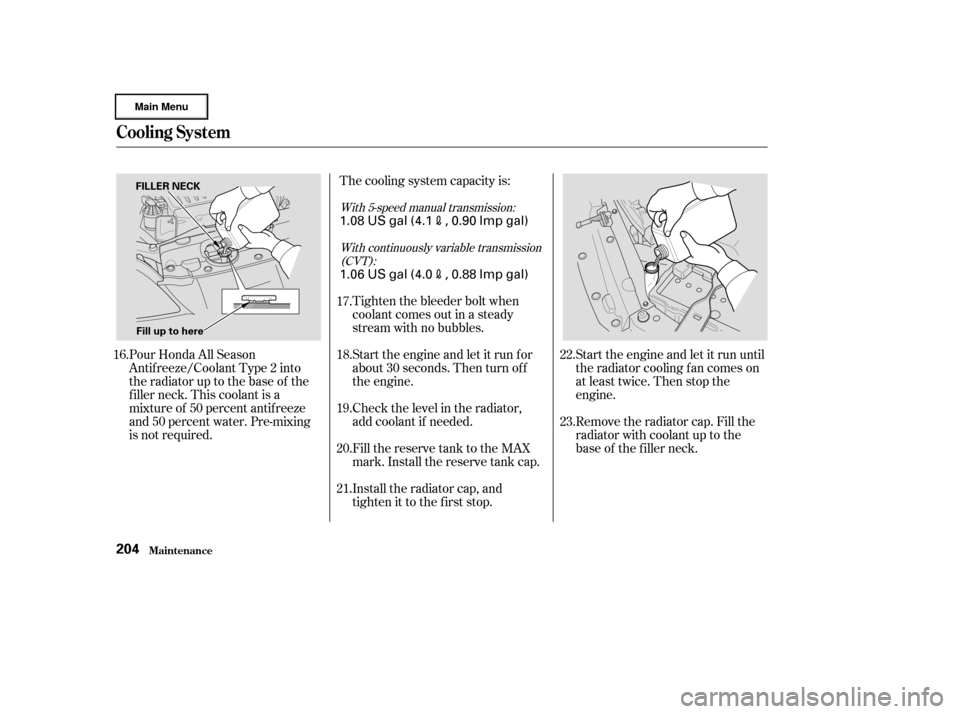
Start the engine and let it run until
the radiator cooling f an comes on
at least twice. Then stop the
engine.
Remove the radiator cap. Fill the
radiator with coolant up to the
base of the f iller neck.
The cooling system capacity is:
Tighten the bleeder bolt when
coolant comes out in a steady
stream with no bubbles.
Start the engine and let it run f or
about 30 seconds. Then turn of f
the engine.
Check the level in the radiator,
add coolant if needed.
Fill the reserve tank to the MAX
mark. Install the reserve tank cap.
Install the radiator cap, and
tighten it to the first stop.
Pour Honda All Season
Antif reeze/Coolant Type 2 into
the radiator up to the base of the
f iller neck. This coolant is a
mixture of 50 percent antif reeze
and 50 percent water. Pre-mixing
is not required.
16.
17.
18.
19.
20.
21.22.
23.
With 5-speed manual transmission:
With continuously variable transmission(CVT):
Cooling Syst em
Maint enance204
FILLER NECK
Fill up to here
1.08 US gal (4.1, 0.90 Imp gal)
1.06 US gal (4.0
, 0.88 Imp gal)
Page 208 of 317
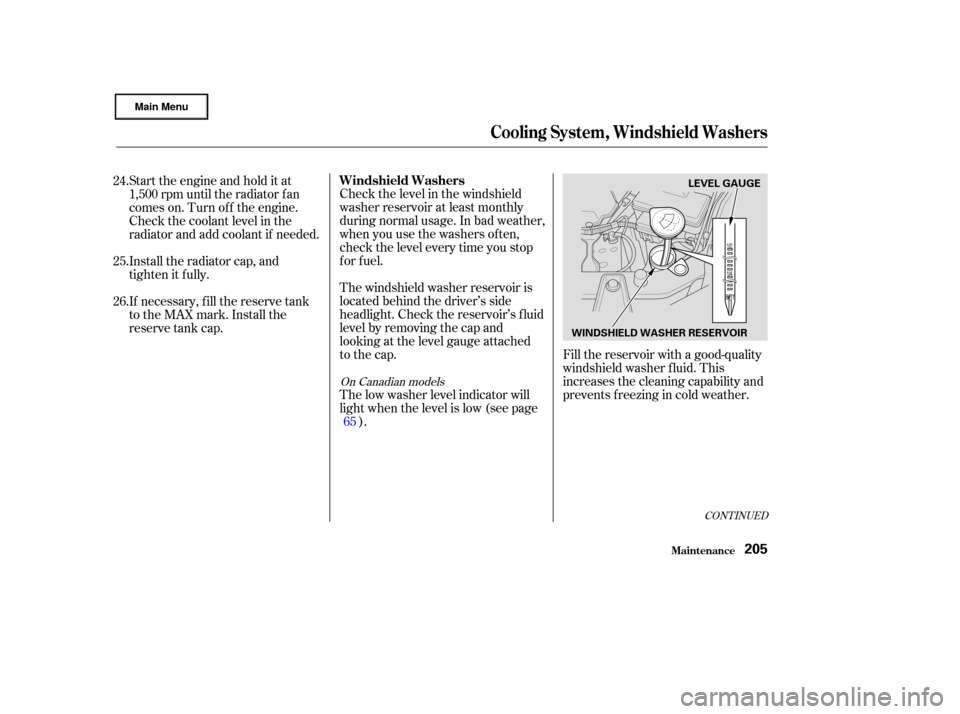
Fill the reservoir with a good-quality
windshield washer f luid. This
increases the cleaning capability and
prevents f reezing in cold weather.
Check the level in the windshield
washer reservoir at least monthly
during normal usage. In bad weather,
when you use the washers of ten,
check the level every time you stop
for fuel.
The windshield washer reservoir is
located behind the driver’s side
headlight. Check the reservoir’s f luid
level by removing the cap and
looking at the level gauge attached
to the cap.
The low washer level indicator will
light when the level is low (see page
).
Start the engine and hold it at
1,500 rpm until the radiator f an
comes on. Turn of f the engine.
Check the coolant level in the
radiator and add coolant if needed.
Install the radiator cap, and
tighten it fully.
If necessary, f ill the reserve tank
to the MAX mark. Install the
reserve tank cap.
65
24.
25.
26.
On Canadian models
CONT INUED
Maint enance
Cooling System, Windshield Washers
Windshield Washers
205
LEVEL GAUGE
WINDSHIELD WASHER RESERVOIR
Page 224 of 317
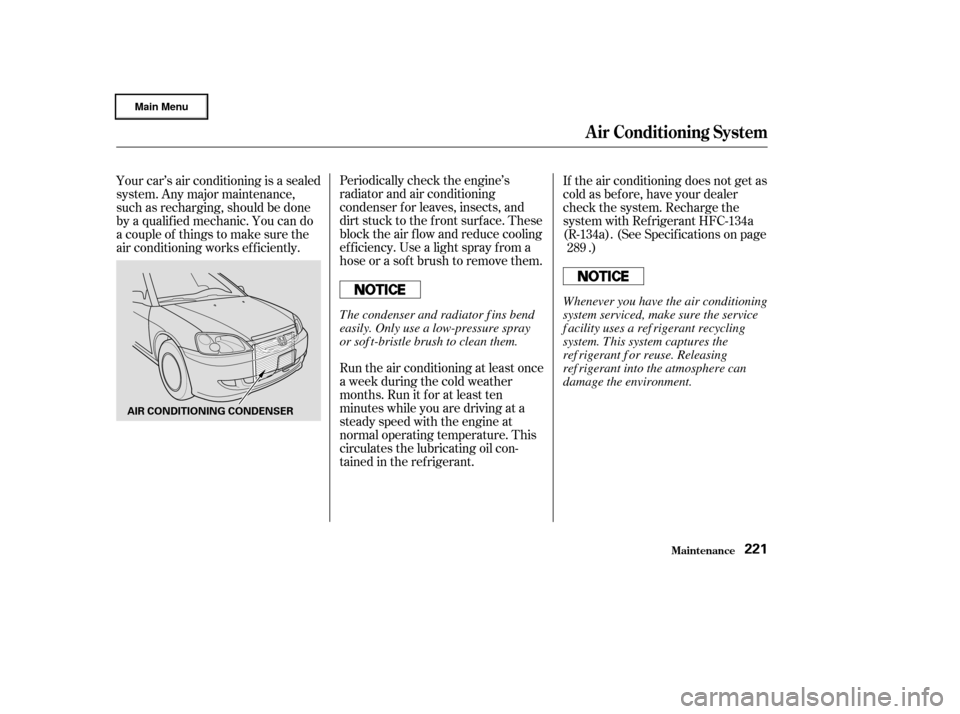
Periodically check the engine’s
radiator and air conditioning
condenser f or leaves, insects, and
dirt stuck to the f ront surf ace. These
block the air f low and reduce cooling
ef f iciency. Use a light spray f rom a
hose or a sof t brush to remove them.If the air conditioning does not get as
cold as before, have your dealer
check the system. Recharge the
system with Ref rigerant HFC-134a
(R-134a). (See Specif ications on page
.)
Run the air conditioning at least once
a week during the cold weather
months. Run it f or at least ten
minutes while you are driving at a
steady speed with the engine at
normal operating temperature. This
circulates the lubricating oil con-
tained in the ref rigerant.
Your car’s air conditioning is a sealed
system. Any major maintenance,
such as recharging, should be done
by a qualif ied mechanic. You can do
a couple of things to make sure the
air conditioning works ef f iciently.
289
A ir Condit ioning Syst em
Maint enance221
AIR CONDITIONING CONDENSER
Whenever you have the air conditioning
system serviced, make sure the service
f acility uses a ref rigerant recycling
system. This system captures the
ref rigerant f or reuse. Releasing
ref rigerant into the atmosphere can
damage the environment.
The condenser and radiator f ins bend
easily. Only use a low-pressure spray
or sof t-bristle brush to clean them.
Page 272 of 317
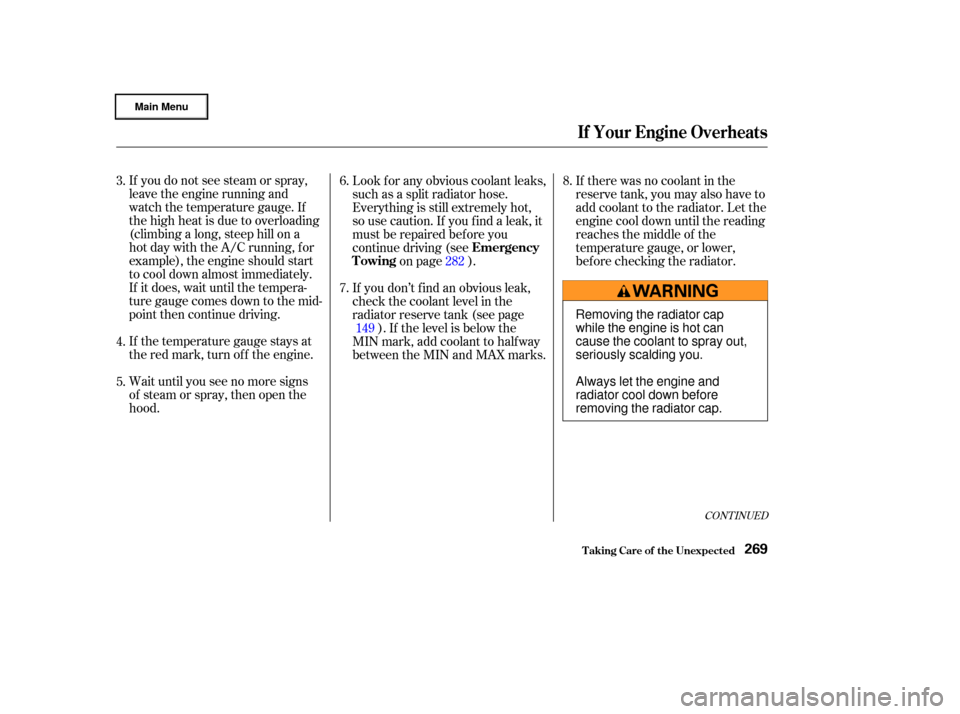
CONT INUED
If you do not see steam or spray,
leave the engine running and
watch the temperature gauge. If
the high heat is due to overloading
(climbing a long, steep hill on a
hot day with the A/C running, f or
example), the engine should start
to cool down almost immediately.
If it does, wait until the tempera-
ture gauge comes down to the mid-
point then continue driving.
If the temperature gauge stays at
the red mark, turn of f the engine.
Wait until you see no more signs
of steam or spray, then open the
hood.Look f or any obvious coolant leaks,
such as a split radiator hose.
Everything is still extremely hot,
so use caution. If you f ind a leak, it
must be repaired bef ore you
continue driving (see
on page ).
If you don’t f ind an obvious leak,
check the coolant level in the
radiator reserve tank (see page ). If the level is below the
MIN mark, add coolant to halfway
between the MIN and MAX marks. If there was no coolant in the
reserve tank, you may also have to
add coolant to the radiator. Let the
engine cool down until the reading
reaches the middle of the
temperature gauge, or lower,
bef ore checking the radiator.
3.
4.
5. 6.
7.
8.
282
149
T aking Care of t he Unexpect ed
If Your Engine Overheats
Emergency
Towing
269
Removing the radiator cap
while the engine is hot can
cause the coolant to spray out,
seriously scalding you.
Always let the engine and
radiator cool down before
removing the radiator cap.
Page 273 of 317

Using gloves or a large heavy
cloth, turn the radiator cap
counterclockwise, without pushing
down, to the f irst stop. This
releases any remaining pressure in
the cooling system. After the
pressure releases, push down on
the cap and turn it until it comes
off.
Start the engine and set the
temperature control dial to
maximum. Add coolant to the
radiator up to the base of the f iller
neck. If you do not have the
proper coolant mixture available,
you can add plain water.
Remember to have the cooling
system drained and ref illed with
the proper mixture as soon as you
can.Put the radiator cap back on
tightly. Run the engine and watch
the temperature gauge. If it goes
back to the red mark, the engine
needs repair. (See
on page .)
If the temperature stays normal,
check the coolant level in the
radiator reserve tank. If it has
gone down, add coolant to the
MAX mark. Put the cap back on
tightly.
9.
10. 11.
12.
282
T aking Care of t he Unexpect ed
If Your Engine Overheats
Emergency
Towing
270
Page 313 of 317
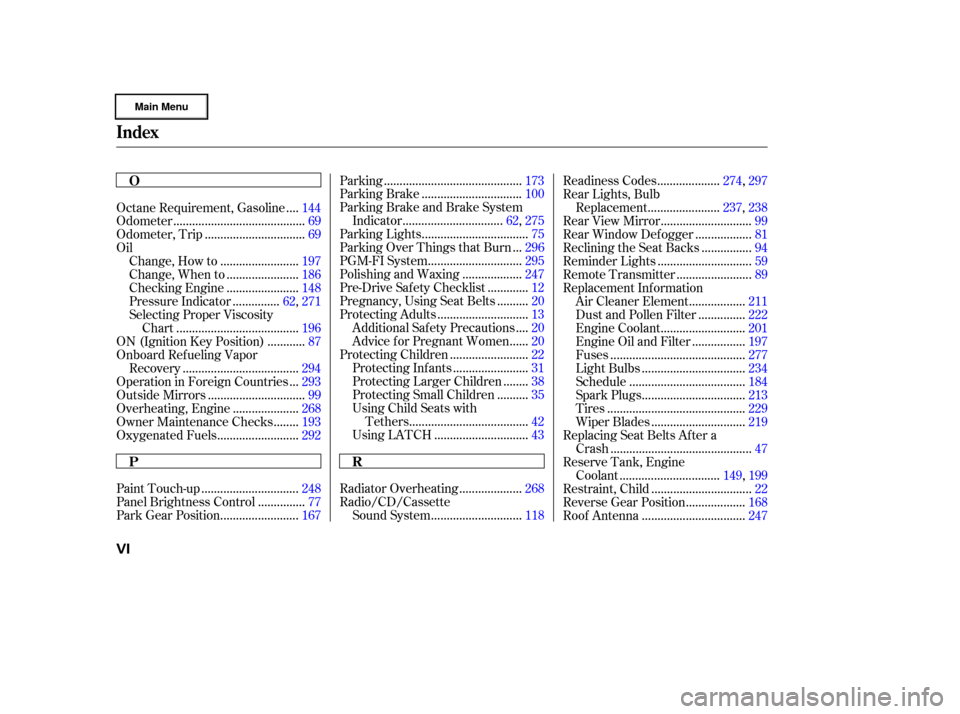
..............................
Paint Touch-up .248
..............
Panel Brightness Control . 77
........................
Park Gear Position .167 ...........................................
Parking .173
...............................
Parking Brake .100
Parking Brake and Brake System ...............................
Indicator .62, 275
.................................
Parking Lights .75
..
Parking Over Things that Burn . 296
.............................
PGM-FI System .295
..................
Polishing and Waxing . 247
............
Pre-Drive Saf ety Checklist . 12
.........
Pregnancy, Using Seat Belts . 20
............................
Protecting Adults .13
...
Additional Safety Precautions . 20
.....
Advice f or Pregnant Women . 20
........................
Protecting Children .22
.......................
Protecting Inf ants .31
.......
Protecting Larger Children . 38
.........
Protecting Small Children . 35
Using Child Seats with .....................................
Tethers .42
.............................
Using LATCH .43
...................
Radiator Overheating . 268
Radio/CD/Cassette ............................
Sound System .118 ...................
Readiness Codes . 274,297
Rear Lights, Bulb ......................
Replacement .237, 238
............................
Rear View Mirror .99
.................
Rear Window Def ogger . 81
...............
Reclining the Seat Backs . 94
.............................
Reminder Lights .59
.......................
Remote Transmitter .89
Replacement Inf ormation .................
Air Cleaner Element . 211
..............
Dust and Pollen Filter . 222
..........................
Engine Coolant .201
................
Engine Oil and Filter . 197
..........................................
Fuses .277
................................
Light Bulbs .234
....................................
Schedule .184
................................
Spark Plugs .213
...........................................
Tires .229
.............................
Wiper Blades .219
Replacing Seat Belts Af ter a ............................................
Crash .47
Reserve Tank, Engine ...............................
Coolant .149, 199
...............................
Restraint, Child .22
..................
Reverse Gear Position . 168
................................
Roof Antenna .247
...
Octane Requirement, Gasoline . 144
.........................................
Odometer .69
...............................
Odometer, Trip .69
Oil ........................
Change, How to .197
......................
Change, When to .186
......................
Checking Engine .148
..............
Pressure Indicator . 62,271
Selecting Proper Viscosity ......................................
Chart .196
...........
ON (Ignition Key Position) . 87
Onboard Ref ueling Vapor ....................................
Recovery .294
..
Operation in Foreign Countries . 293
..............................
Outside Mirrors .99
....................
Overheating, Engine .268
.......
Owner Maintenance Checks . 193
.........................
Oxygenated Fuels .292
Index
PR O
VI